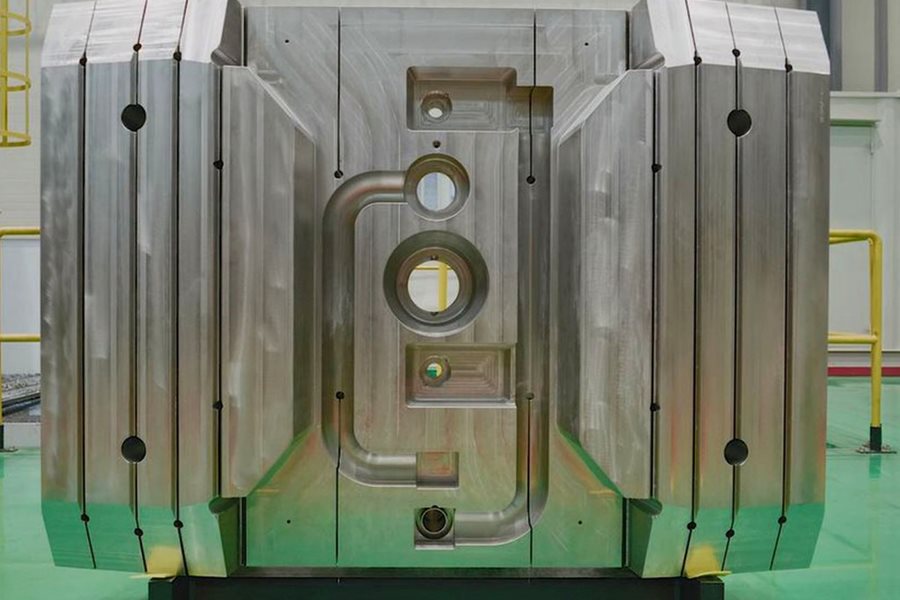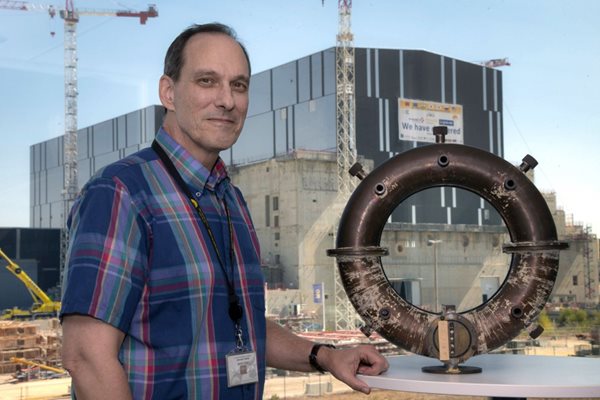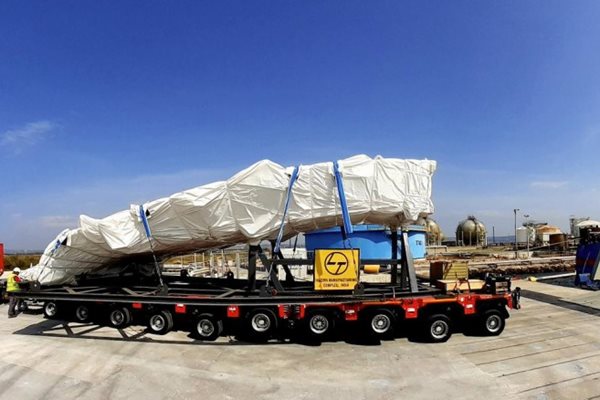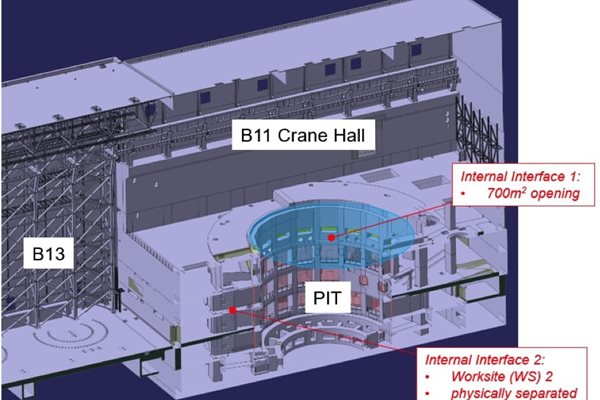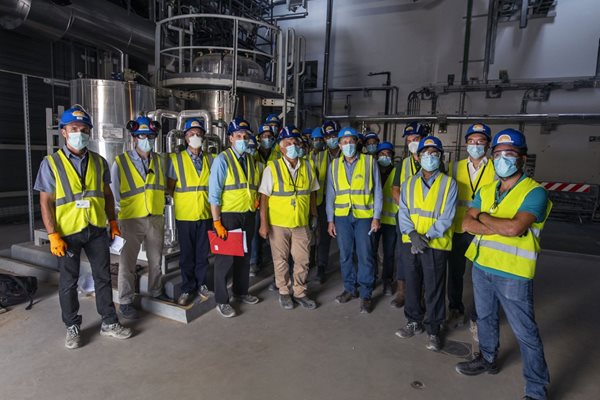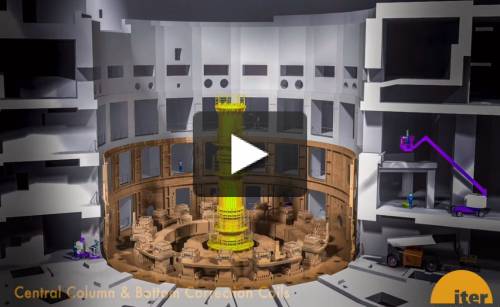
you're currently reading the news digest published from 14 Sep 2020 to 21 Sep 2020
featured4
of-interest2
video1
press4
featured
Blanket shield blocks | Series production milestone in Korea
It takes many months for a single forged block of stainless steel to be transformed into the complex shape of an ITER blanket shield block, full of gullies, channels, gaps, and cutouts. In Korea, series production is underway and a major milestone has been achieved: the successful testing and certification of the first production unit. Eighteen rows of blanket shield blocks (440 individual blocks) will line the inner surfaces of the ITER vacuum vessel to protect the steel of the vessel as well as the coil systems from fusion neutrons. Very few of the shield blocks are identical, making this a complex industrial package. The variations in design are related to the specific position of the shield blocks in the vacuum vessel (driven by the local geometry in the inboard and outboard regions) as well as the space requirements of interfacing systems such as plasma heating and diagnostics. The Domestic Agencies of Korea and China are procuring 220 units each. The blanket shield blocks—and their front-facing first wall panels—are required on site at ITER in time for installation during Assembly Phase II (2026 to 2028). The basic fabrication method for a shield block involves the extensive transformation of a forged stainless steel block through precise machining, deep hole drilling, and the welding of cover plates over the cooling channels; a number of deep slits are also machined into the shield block for the purpose of reducing the impact of electromagnetic loads. As a final fabrication step, the components undergo non-destructive examination at the factory as well as hydraulic pressure and hot helium leak testing. ITER Korea has been cooperating with domestic industries EM Korea Co., Ltd., and Vitzrotech Co., Ltd. since 2017 to manufacture and test its portion of the shield blocks, with actual series production beginning in August 2019 after the completion of qualification activities including the fabrication and testing of a full-scale prototype. The first series production unit, SB06A—for row 6 (situated near the top of the vessel on the inboard wall of the chamber), type A—has now been completed in Korea, including factory acceptance tests and the production of all required documentation. For future series production units, it is expected that the manufacturing can be accelerated through the experience gained and strong production and quality management systems. Rene Raffray, Blanket Integrated Product Team Leader, congratulated Korean colleagues on the achievement of this important milestone. 'This is not only the first series production shield block to be completed in Korea but also the first major series component of the blanket system to be successfully manufactured and tested, and as such it is a major step forward. It also testifies to the strong progress in the procurement of the shield blocks and to the productive collaboration between the ITER Organization and the procuring Domestic Agencies.' The Director-General of ITER Korea, Kijung JUNG, took pride in the accomplishment, saying: 'We are happy to be engaging in some of the most difficult challenges in terms of fusion technology, so that our industry will be ready for the commercialization of hydrogen fusion. After the recent successes on the ITER vacuum vessel, we know we are strengthening the capabilities of our domestic industries through participation in ITER.' In parallel, procurement is also progressing well in China, with all shield blocks in rows 09 and 10 in series production, as well as several for row 17. Final machining has been completed on one row 10 shield block and final factory acceptance tests are underway. Find out more about the ITER blanket.
Top management | Tim Luce, Head of Science & Operation
What does a seven-year-old growing up in a small community in Arkansas know about what it means to be an 'atomic scientist'? Probably not much. Except, remembers ITER Chief Scientist Tim Luce, that 'it sounded cool ...' Although Dad was an agricultural engineer and Mom a trained dietitian who became a schoolteacher, 'the quest for knowledge was not encouraged' in Tim's childhood environment. But there were books to answer a young boy's questions and Tim fondly remembers the popular series 'The How and Why Wonder Book of Science,' which he devoured. 'The 1960s were a Golden Age for understanding how things worked and how to fix them,' he reflects today. Men were going into space, soon to reach the Moon. And there was the promise of fusion. In New York, the most exciting attraction at the 1964 World Fair was a 'nuclear fusion demonstration' that produced 'fusion bangs' every 4-6 minutes ... Maybe the noise was heard as far away as Arkansas and registered on the young boy's curious mind. Years later, in high school, Tim remembers writing a report on fusion—but confesses having 'zero idea of what triggered his interest.' Another brush with fusion occurred when Tim was a student at the University of Arkansas. One of his professors had done work on pinch devices, one of the early fusion machine concepts. Tim's interest was aroused—why not venture into the realm of hot plasmas and colliding nuclei, and explore 'this fantastic scientific problem and its potential application to society'? There was a place where a brilliant physics major ('with zero plasma physics training but good basis in thermodynamics') could do exactly that: Princeton University, the Mecca of fusion. 'It cost 25 dollars to apply. I took my chance. And I got in.' In terms of fusion research, Princeton in the mid-1980s was 'a fantastic place to be'—great teachers, great machines, and the best 'plasma education' one could dream of. Operating since 1975, the Princeton Large Torus (PLT) had broken new ground in plasma temperature and the Tokamak Fusion Test Reactor (TFTR), which produced its first plasma in 1982, was one of the most powerful tokamaks of the time. As for the human and intellectual environment, 'all the guys you now read about in history books were there ... all the big names, just across the corridor.' Working on microwave diagnostics on PLT, 'with TFTR around the corner,' Tim, still in his twenties, was part of a worldwide quest that had never seemed more promising. After the Golden Age of mechanics of his childhood, came the Golden Age of fusion devices: half a dozen of them in the US alone, TFR in France, the European JET a few years away, ASDEX starting in Germany, JT-60 in Japan, T-15 in the then Soviet Union ... In California, General Atomics had just started DIII-D—not the most advanced or the most powerful of tokamaks, but one that a young Princeton graduate could 'get his hands on.' 'The staff was so small,' Tim remembers, 'that we'd get our hands into everything, learn by doing and devise complementary experiments that we performed on other machines.' Tim was to remain 30 years at General Atomics, while spending some 25 percent of his time abroad in the early years, experimenting on other machines and interacting with the world fusion community. 'All the leaders of today, we worked together as kids...' Tim was not 30 yet when he attended his first ITER meeting in 1989. 'I thought: here is my career. And I have spent the past two decades paving the way to fusion as an energy source.' In September 2017, 28 years after that first meeting, Tim was appointed Head of the ITER Science, Controls & Operation Department. From this year, as acting Domain Head for Science & Operation, his responsibility has dramatically expanded. 'Beyond furthering the physics R&D and working to shorten the learning curve, my job, basically, is to solve problems, many of them logistical problems like tracking the delivery of systems or preparing paperwork for licensing.' Like the young boy that he once was, Tim continues to ponder the same questions—'What do I not know? What can I better understand? What can I solve?' Except that, now, he is the one writing the new chapter of 'The How and Why Wonder Book of Science.'
Image of the week | 5 top lid segments expected
A little less than five years ago, in December 2015, the first segments of the ITER cryostat (out of a total of 54) were delivered to the construction site from India. Of the four sections that make up this massive 'thermos,' two—the base and lower cylinder—are now installed in the assembly pit and one, the upper cylinder, is safely stored on the platform in a protective cocoon. The required segments for the fourth section—the 'top lid'—were finalized in June and a first batch was shipped to France in late August. Consisting of 5 top lid segments (out of a total of 12) and one central cover, the sub-components were unloaded at Marseille-Fos harbour on 8 September and are due on the ITER site this week. A second batch with the remaining 7 top lid sectors is scheduled to leave India in October.
On site | As ITER begins assembly, HVAC becomes mission critical
Not only will heating, ventilation and air conditioning (HVAC) help protect people and equipment during the assembly phase at ITER, but they will also help ensure cleanliness in preparation for First Plasma. The ITER Organization will contract for two temporary and independent HVAC systems that will be installed to support the assembly phase at ITER. One of the HVAC systems will serve Worksite 1, which includes the Assembly Building, the crane hall, and the Tokamak pit. The other will serve Worksite 2, also known as the Tokamak Complex, which includes the Tokamak, Diagnostic and Tritium buildings. Ensuring temperature, humidity and cleanliness 'At Worksite 1, we have to maintain the temperature, humidity and cleanliness to support machine construction,' says Giovanni Di Giuseppe, Section Leader of the Supply & Service Installation Section. 'This means maintaining a temperature of 20 °C +/- 2 °C in the winter, and 25 °C +/- 2 °C in the summer. Humidity has to be kept below 70 percent, and cleanliness has to conform to ISO 9 [code 14661] requirements.' One of the goals is to maintain homogenous temperatures between the Assembly Hall—where a powerful HVAC system is already functioning—and the crane hall and the Tokamak pit. A change of a few degrees could introduce minute changes in component dimensions that would make it difficult to fit components together during assembly. Maintaining a constant temperature involves heating and air conditioning, but it also involves ventilation to remove the heat generated by workers and by welds. More than twenty 'hot points,' or welding stations, will be situated in the Tokamak pit. Not only do the welds produce heat that needs to be removed, but they also produce argon which, if left in the pit, would pose a double threat: argon causes anoxia and it triggers fire. 'To extract the fumes resulting from the welding we will use specialized equipment, including mobile source capture systems,' says Di Giuseppe. 'We need to locate the equipment in the crane hall in order to route the ducts inside the pit.' French labour code requires a ventilation system that provides 60 m³ of air per hour per worker. None of that air is recycled, so the ventilation system will have to include both supply ducts and exhaust ducts. The ventilation system will accommodate up to 140 workers, which is the maximum number of people allowed in the Tokamak pit at the same time. One source of complexity, especially in the Tokamak pit, is that as the machine is constructed, dead zones arise. These areas start out as big, relatively empty volumes that are easy to ventilate, but gradually they get filled with components—and these components create pockets of trapped air. 'Worksite 2 will be a little easier,' says Di Giuseppe. 'There are no specific temperature or humidity requirements for equipment; however, we do need to maintain conditions that conform with French labour law. There will also be specific activities we will have to support with air locks (isolated rooms where temperature and cleanliness control is required). These activities include cryoline installation, vacuum installation, and Tokamak cooling water system installation. The air locks have to be interfaced to the local ventilation system.' 'For the rest of the work areas, we need to condition the environment for worker safety, knowing that as many as 180 people may be on three of the building levels at any given time,' says Di Giuseppe. 'We will put sensors in place to read pollution levels at both worksites. A special team will go on site periodically to read the measurements and check that the pollution is within ISO 9 levels.' Beyond worker safety and equipment protection, HVAC will support ITER efforts to maintain cleanliness, especially in the Assembly Hall. Ventilation will help keep dust and sub-microscopic particles off components that will ultimately wind up in the vacuum vessel. Any contaminants left on such components could reduce fusion output. 'During the year 2019, we ran a feasibility study for the temporary ventilation requirements,' says Di Giuseppe. 'We identified the needs, and laid out the main features of how we will implement the temporary ventilation systems. We would like to award the contracts in the fall and start work by the beginning of next year.'
of-interest
Register now: European Fusion Teacher Day
Secondary school teachers across Europe are invited to participate virtually in the 2020 European Fusion Teacher Day, hosted by FuseNet, the European Fusion Education Network. Registration for the 2 October event closes on 27 September. The European Fusion Teacher Day will premiere new education materials for the classroom, offer a behind-the-scenes look at international fusion experiments such as ITER, JET and GOLEM, and host a live connection with teachers throughout Europe. At the end of the event you will be able to tell your students all about nuclear fusion: from the cutting-edge research that is going on, to how to make fusion a career. For the first part of the event, participants will join video calls in the language of their choice, hosted by fusion institutes in Austria, Bulgaria, the Czech Republic, France, Germany, the Netherlands, Portugal, Slovenia, Spain, Sweden, Ukraine, and the United Kingdom. An introductory lecture followed by a presentation of newly developed classroom materials will be the highlights of this part of the program. Then, all participants will tune into a livestream (in English) with fusion students and scientists located on site at three tokamak facilities: ITER, JET and GOLEM. For more information on how to participate, see FuseNet.
Chiller plant ready for testing
On 17 September, the chiller plant in the Site Services Building was turned over to the ITER Science, Controls & Operation Department (SCOD) for commissioning. This is the first of many handovers to come between the ITER construction and operation teams, and it signals that equipment installation is complete. Now, a commissioning team led by SCOD will start to energize the equipment, fill the pipes, and test the circuits and related control interfaces. The chiller plant is one element of the chilled water system that is, in turn, part of the overall ITER cooling water system. The tokamak cooling water system, the component cooling water system, the chilled water system and the heat rejection system are together responsible for removing the enormous amounts of heat generated by the tokamak and its auxiliary systems.
